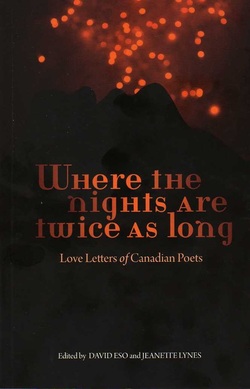|
0 Comments
 Where the Nights Are Twice As Long: Love Letters of Canadian Poets 1883-2014. Ed. David Eso and Jeanette Lynes. Fredericton: Goose Lane, 2015. 430 pp. $22.95. This anthology is an unofficial sequel to – or one-upping of – Irving Layton’s 1962 poetry anthology Love Where the Nights Are Long, a McClelland & Stewart collection that is still in print. At 430 pages to Layton’s 78, the new one is not just twice but five times as long. Length, of course, doesn’t necessarily correlate with endurance – in books, ‘love,’ or even in the game of bridge, as that legendary bridge player who lamented “I’ve got length but no strength” evidently had discovered. The new collection consists of both love letters and "epistolary poems," by poets both well-known and obscure, with some of the love letters addressed to named recipients, some not, and the addressees of most of the poems unidentified. Readers are thus frequently given the erotic pleasure of guessing. Dave Eso’s preface suggests that the editors did considerable research in university manuscript collections and Canada's National Archives for possible inclusions. He reports however – not surprisingly – that “[p]ermission to reprint many personally revealing letters discovered in the course of our research was not granted; in response to our request for romantic epistles from our nation’s living poets, we received at least as many refusals as submissions” (12). Perhaps that is why there is only a recent poem from George Bowering, and no letters or poems from Margaret Atwood, David McFadden, Michael Ondaatje, D.G. Jones, bpNichol, Diana Hartog, Christopher Dewdney, Jay Macpherson or Fred Wah – to name only a few whom of those known – out upon it – to have ‘loved’. Or perhaps the editors didn’t look all that deeply into the archives of living and loving poets. Whatever, though I have a poem here, I am happy enough that no private letter of mine was lured out for extra readers and new affection. More thoughts about that transforming process later. Eso also indicates that he and Lynes issued some sort of general call for submissions: “The editors took care to reach out to various poetic camps, from spoken word to conceptual literature” (13). I didn’t see any of those reach-outs but I assume that they may be responsible for the presence of a number of contributors whose poetry work I haven’t seen before, or heard of. Whether these contribute letters or epistolary poems, they are disadvantaged here by the fact that most readers will have to read these without much insight into how their writers have become known as poets, or much sense of time-inhabiting person who accompanies the text. For I suspect that it is the context of a publicly-led poetry life that can give the strongest interest and meaning to missives like these . If we don’t know much about the poet's work overall, a |
Categories
All
Archives
January 2022
|
 RSS Feed
RSS Feed